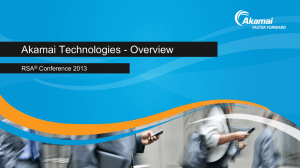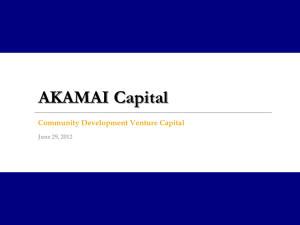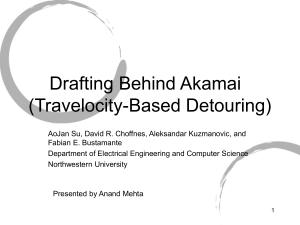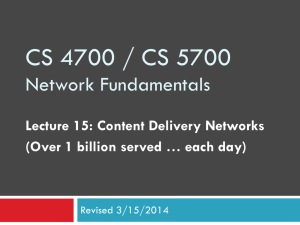Document
advertisement
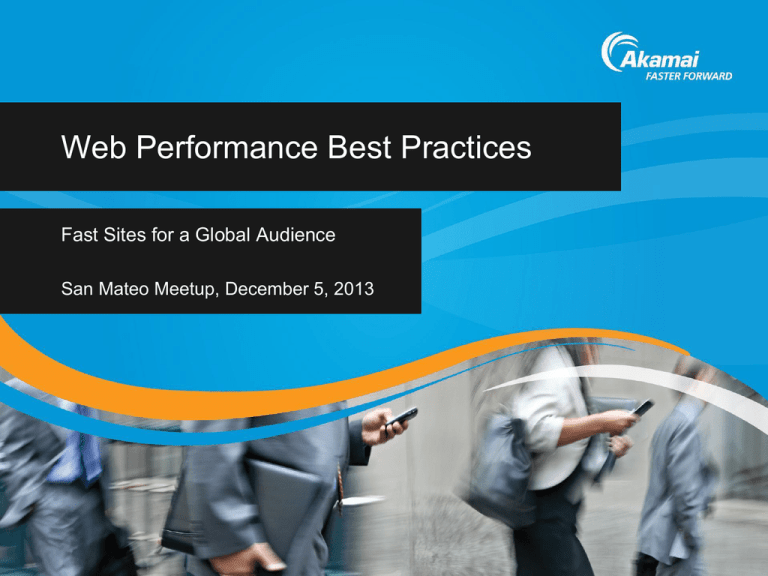
Web Performance Best Practices
Fast Sites for a Global Audience
San Mateo Meetup, December 5, 2013
©2013 AKAMAI | FASTER FORWARDTM
Welcome!
Introduction
• Who We Are
• Why Performance Matters
Web Performance Best Practices
• Measured vs Perceived Performance
• Well-known Best Practices
• Using a CDN – Practical Considerations
Some Real-World Use Cases
©2013 AKAMAI | FASTER FORWARDTM
Who We Are
Javier Garza
David Bartosh
Enterprise Architect
jgarza@akamai.com
Enterprise Architect
dbartosh@akamai.com
©2013 AKAMAI | FASTER FORWARDTM
Why Web Site Performance Matters
Gomez
• For e-commerce, conversion rate increases 74% when page
load time decreases from 8 to 2 seconds.*
Computer and Equation Research
• 71% of mobile web users expect website performance on
their mobile phones to be equal to, or better than, what they
experience on their desktops -- up from 58% in 2009.*
Google
• Is incorporating page performance data in its ranking.**
* Source http://newsletter.sli-systems.com/2012/04
** Source http://googlewebmastercentral.blogspot.com/2010/04/using-site-speed-in-web-search-ranking.html
©2013 AKAMAI | FASTER FORWARDTM
But Web Site Complexity is Always Increasing
Our applications are complex, and growing…
Source: Ilya Grigorik
©2013 AKAMAI | FASTER FORWARDTM
Measured vs. Perceived
Performance
©2013 AKAMAI | FASTER FORWARDTM
Quick Review of Browser Behaviors
The One Rule:
Anything that introduces uncertainty into
how the page should be rendered will block
rendering until it's resolved.
Javascript
CSS
Long load times
©2013 AKAMAI | FASTER FORWARDTM
Measured Performance: Definition
Performance is typically measured by the elapsed time between the “navigationStart” event
(after the browser has unloaded the current document) and the start of the "onload" event
(“loadEventStart”) for the new page, after all resources (HTML, images, CSS, JavaScript) have
been downloaded.
Source: W3C
©2013 AKAMAI | FASTER FORWARDTM
Measured Performance: Standard Optimizations
• Use compression, consolidate and minimize (minify) text files
(CSS, HTML, JavaScript)
• Use sprites for small images
• Only include resources the page actually requires
• Minimize header payloads, for example, by using different
domains for static objects to avoid unnecessary client cookies
©2013 AKAMAI | FASTER FORWARDTM
Measured Performance: Standard Optimizations
• Use resource inlining and domain sharding (use shards with
caution on mobile-centric or responsive sites)
• Maintain persistent connections (HTTP keep-alive)
• Now make it global… Leverage a Content Distribution
Network (CDN) for static object caching close to users, for
route optimization, and for additional content acceleration
techniques (object/page prefetching, advanced failover, etc.)
©2013 AKAMAI | FASTER FORWARDTM
Perceived Performance: What is it?
• No browser-independent, agreed upon metric as of yet.
• Loosely defined as either when all elements in viewing area
have been painted or when user sees enough information to
interact with the site.
• WebPageTest.org uses the % of viewport paint completion as
a metric.
• There is usually a strong correlation between “measured” and
“perceived” performance.
• If care is not given to perceived performance, user experience
can be negatively impacted, even if real performance metrics
are positive.
©2013 AKAMAI | FASTER FORWARDTM
Perceived Performance: Standard Optimizations
• Maximize downstream Time-to-Live (TTL) – browser cache
can’t be purged, so make static object filenames unique
(fingerprinting) and use an “infinite” TTL.
• Make JavaScript asynchronous, remove from HTML <head>,
and avoid DOM modification via script wherever possible.
• Reduce the number of domains used (especially third party
domains).
• Optimize images by reducing quality and using progressive
rendering, and use “lazy-loading” for content below the fold.
• Continually evaluate cookie collection/size and usage.
©2013 AKAMAI | FASTER FORWARDTM
When Measured and Perceived Meet…
3.044s
7.066s
Waterfall without Front-End Optimizations
Waterfall with Front-End Optimizations
56.9%
Faster
©2013 AKAMAI | FASTER FORWARDTM
When Measured and Perceived Meet…
©2013 AKAMAI | FASTER FORWARDTM
Well-Known Best Practices
(Thank you, Steve Souders!)
©2013 AKAMAI | FASTER FORWARDTM
Well-known Best Practices
• Optimizing caching — keeping your application's data and
logic off the network altogether
End
End User
User #1
#1
Browser
Browser Cache
Cache
Cache-Control: private, no-store
ISP #1
Proxy
Origin
Origin Server
Server
CDN Server
ISP #2
Proxy
End
End User
User #2
#2
Browser
Browser Cache
Cache
Cache-Control: public
Expires: Fri, 06 Dec 2013 00:00:00 GMT
Cache-Control: public, max-age=31536000
Last-Modified: Tue, 05 Nov 2013 23:33:50 GMT
Cache-Control: public
Expires: Fri, 06 Dec 2014 00:00:00 GMT
/style-Bb752799d39de9dc7c186802ea1eaf84.css
/logo-E8f51d6221bcc66b381c3b72619bce70.jpg
/notify-40d68a1163b9870406ba588709f1507f.js
As listed on: https://developers.google.com/speed/docs/best-practices/rules_intro
©2013 AKAMAI | FASTER FORWARDTM
Akamai FEO automation can
create fingerprinted filenames
automatically for your static
content, both in browser cache
and HTML5 local storage.
Well-known Best Practices
• Minimizing round-trip times — reducing the number of serial
request-response cycles
Number of Domains
static4.domain.com
static1.domain.com
static7.domain.com
static8.domain.com
static3.domain.com
static6.domain.com
static4.domain.com
static2.domain.com
Order of Styles and Scripts**
Akamai “System Scripts”
take content inlined into
the initial HTML request
and writes individual
objects to HTML5 Local
Storage, and on
subsequent requests, the
returned HTML will refer
to the files in Local Storage
(not inlined any more).
Number of Requests (Combining Images, CSS + JS)*
Prefer Asynchronous Resources***
* http://www.yourinspirationweb.com/en/how-to-increase-the-performance-of-a-website-with-css-sprites/
** https://developers.google.com/speed/docs/best-practices/rules_intro
*** https://www.daycounts.com/shop/plugins/javascript-async-defer-detail
©2013 AKAMAI | FASTER FORWARDTM
Well-known Best Practices
• Minimizing request overhead — reducing upload size
My Windows Live ID Cookie:
Cookie: wlp=A|9a0z-t:a*+1g6CQ._:h*lrY/CQ.Color_Blue; MUID=3FBEECBBE1D462AD1F5CE989E2D46209; skyjsTabId=1; skyjsTabActive=1; s_vsn_skyperendezvous-ol=4603398481849; wla42=;
mbox=PC#1385500405328-646453.19_29#1387247853|check#true#1386038313|session#1386038252124-984802#1386040113; wlidperf=throughput=1&latency=3182&FR=L&ST=1386038256477; PPLState=1;
MSPAuth=2F0Y29nBUFxm7S9ASH3z2lLAth15kHwIwL1KyC4yK046ahVQwZDYQbJBeV!cg2qbSxQdTe1EE4GRfagxkWSBMpyngFmo3HpzZPuBJupcgtw3pDPzBL74CDo!rKNwBAc69C;
MSPProf=2P3tLXVLvD5PVHLGWbCJkyyz2zUlu3ArRRE!IATPEx6Lj0r*Rlk1M4nbsRK4nBWLj!OxvgmcXA1dSlpaqdNSl0owO4pf82cyoyvPFXHdPOKTj3qlPTloZ!o2AqTrgbXHXSGBpQpbXC4Ly8AB2qpig8NjC1pLhoia5
ozL0AOBCf2SwTgL6lZsBuXw8dw!0svabs; MH=MSFT; NAP=V=1.9&E=e82&C=huQrfRMnexbMCcpHS0BySjtbjvEyN1GuaLdH0Kh6Cee6lRbLiO-vFw&W=1;
ANON=A=3E85CA0A4818AE1ED161F41CFFFFFFFF&E=edc&W=1;
WLSSC=EgBoAQMAAAAEgAAAC4AAzvFu5rZSyzMqMXKWSXmyWGn9ZCGR5falZIwVi2xH/Q3xVyRFyEP4y6WtH4FG+z3B2UdZO2RMq3VXs/RBt30W2lRO4tReO8U9/WrpMc1jiFsZ+BvN049A8A5MNrS5ZwI/Nolei8
lac+0fVOXApuAj0ZThAzo/lkHi3bCqo+QiDVDXAGAA1wCnGwEAhF0vTPBDnVLwQ51SECcAAAoQoAAwFQBkYmFydG9zaEBob3RtYWlsLmNvbQBQAAAUZGJhcnRvc2hAaG90bWFpbC5jb20AAAAwVVMABTk4MTI
2AACMAQQJAgAAY6lNQBAUQwAFRGF2aWQAB0JhcnRvc2gEXwABVwAAAAAAAAAAAADo3uAljZVmMQAA8EOdUvC4r1IAAAAAAAAAAAAAAAANADIzLjc5LjIzMS4xNAAFAAAAAAAAAAAAAAAAAAEAAAEAA
AEAAAEAAAAAAAAAAAAA; KVC=17.1.7118.6000; mt=01_92dabd989a36d9368a0e72467d6753cdca3acb4d8a9cd64efdfc8115d43f7526|fc178b0adc439c31; xid=9d3b00b0-d585-45f1-b738fa8c9a3439ee&kN00L&BLU171-W139&387; xidseq=1; mkt=en-US; upcb=0; crms=0TT; E=P:Os7JxOe90Ig=:8GE3Qx3nk8d4RNR/cT7kfHiXHC4ln+WgWmOeOAU75ho=:F; wls=A|9a0z-t:a*n:h*m; wlv=A|9a0zd:s*c8EjCw.2+1+0+3;
KSC=hAkdcx8gQ3v4FwX6sdiZqXaUNKgJo7mN5SzCdNslc9U01J2136YD84NZemf0hnZMowvivG8wg5XM4yygTsbXu4NT5Wz2CryD5le3rIWOqSum2aXAlr3UstPHjSSOExRnEb2RhgbW2oo7rRBoLQyTZtFoaBIDBv83
1JobVdAziWTcD5uuPdiBcOOaQ7sV5Qu/Hbex+Z0KadcseA68mEch2F8pB7vztpR52JRcFeK7CiWygf2BnwjDhTdlBJ75mz9l7lc5gE6NN1KtvuVP9TfjotlutGJVn/OrLuJA8wjbI98lYim7TdIexDc1g+mY69CZ5WjTfa0Mf3Z2
QgtTAduFPryW9k1ai2ri63JM4asV/Rc=; UIC=qskPgrnnjKiZI9+FNXn56C/PNAyeb+XFUVpDJqywbBdsvGNV9m+luxr4vBh+mVPldxZWEx5Mzze5g7lG7xwtk9u1TuJf1FvGbt1p9G6eE4bwj/SbxGefa1vBF00NYdKf;
HIC=8d956631e8dee025|0|35|blu171|1761|blu171
2KB
Keep that all on the server, and know me by an identifier cookie:
0.2KB
Cookie: MSPProf=2P3tLXVLvD5PVHLGWbCJkyyz2zUlu3ArRRE!IATPEx6Lj0r*Rlk1M4nbsRK4nBWLj!OxvgmcXA1dSlpaqdNSl0owO4pf82cyoyvPFXHdPOKTj3qlPTloZ!o2AqTrgbXHXSGBpQpbXC4Ly8AB2qpig8NjC1pLhoia5ozL0AOBCf2SwTgL6lZsBuXw8dw!0svabs
And use cookie-less domains for static content:
0.0KB
As listed on: https://developers.google.com/speed/docs/best-practices/rules_intro
©2013 AKAMAI | FASTER FORWARDTM
Akamai FEO automation
automatically creates
cookie-less shards for
optimized resources
using different domains;
the number of shards is
configurable.
Well-known Best Practices
• Minimizing payload size — reducing the size of responses,
downloads, and cached pages
437B
1
// is.js
// (c) 2001 Douglas Crockford
// 2001 June 3
// is
var is={ie:navigator.appName=='Microsoft Internet
Explorer',java:navigator.javaEnabled(),ns:navigator.appName=='Netscape',ua:navigat
or.userAgent.toLowerCase(),version:parseFloat(navigator.appVersion.substr(21))||pa
rseFloat(navigator.appVersion),win:navigator.platform=='Win32'}
is.mac=is.ua.indexOf('mac')>=0;if(is.ua.indexOf('opera')>=0){is.ie=is.ns=false;is.
opera=true;} if(is.ua.indexOf('gecko')>=0){is.ie=is.ns=false;is.gecko=true;}}
1004B
// The -is- object is used to identify the browser. Every
browser edition
// identifies itself, but there is no standard way of doing
it, and some of
// the identification is deceptive. This is because the
authors of web
// browsers are liars. For example, Microsoft's IE browsers
claim to be
// Mozilla 4. Netscape 6 claims to be version 5.
var is = {
ie:
Explorer',
java:
ns:
ua:
version:
2
3
navigator.appName == 'Microsoft Internet
navigator.javaEnabled(),
navigator.appName == 'Netscape',
navigator.userAgent.toLowerCase(),
parseFloat(navigator.appVersion.substr(21)) ||
parseFloat(navigator.appVersion),
navigator.platform == 'Win32'
win:
}
is.mac = is.ua.indexOf('mac') >= 0;
if (is.ua.indexOf('opera') >= 0) {
is.ie = is.ns = false;
is.opera = true;
}
if (is.ua.indexOf('gecko') >= 0) {
is.ie = is.ns = false;
is.gecko = true;
}
494B
235B
Example minified script: http://www.crockford.com/javascript/jsmin.html
As listed on: https://developers.google.com/speed/docs/best-practices/rules_intro
©2013 AKAMAI | FASTER FORWARDTM
Minification is part of
Akamai FEO’s most basic
CSS and JS optimizations,
which also include
automated versioning,
fingerprinted filenames and
sharding.
Well-known Best Practices
• Optimizing browser rendering — improving the browser's
layout of a page. First, some details on CSS selectors.
Avoid a universal key selector
body * {...} = BAD
Use class selectors instead of descendant selectors
ul li {color: blue;} = BAD
.unordered-list-item {color: blue;} = BETTER
Remove redundant qualifiers
ul#top_blue_nav {...} = BAD
Important Note! We won’t fix bad CSS… This
one’s on your developers!
#top_blue_nav {...} = BETTER
Avoid using descendant selectors, especially those that specify redundant ancestors
body ul li a {...} = BAD (all elements are descendants of the body tag)
Avoid the :hover pseudo-selector for non-link elements for IE clients
h3:hover {...} = BAD (for MSIE clients)
As listed on: https://developers.google.com/speed/docs/best-practices/rules_intro
©2013 AKAMAI | FASTER FORWARDTM
Well-known Best Practices
• Optimizing browser rendering – cont’d
• Avoid CSS Expressions (deprecated), put CSS
in the document head, using the <link> and
<style> tags, and don't use @import.
• Specify image dimensions in the <img> (and/or
<table> and <td>) element or block-level
parent, and use dimensions that match those
of the actual images (e.g. - don’t scale via the
front-end).
• Specify a character set in the HTTP response
headers of your HTML documents; the preferred
method is to return a “Content-Type” header
with proper “charset,” or use an HTML “meta”
tag, and if you use both, make sure they match!
As listed on: https://developers.google.com/speed/docs/best-practices/rules_intro
©2013 AKAMAI | FASTER FORWARDTM
Akamai FEO tools will
automatically convert
@import references
into <link> elements.
Akamai has multiple
products that
compress, resize and
deliver according to
device and network
characteristics
automatically. FEO
with “Responsive
Image Loading” will
create images best
suited for mobile
devices.
Well-known Best Practices
• Optimizing for mobile — tuning a site for the characteristics of
mobile networks and mobile devices
• Defer parsing of JavaScript or use “async” (per earlier examples)
• Make landing page redirects cacheable.
•
What Google says: use a 302 redirect with a cache lifetime of one
day, including a “Vary: User-Agent” header as well as a “CacheControl: private” header.
•
What Akamai says (if Akamai is your CDN partner): use a 301
redirect without any “Vary” header but where Akamai’s custom
“User-Agent” token (or any Edge Device Characterization feature
the origin uses to serve the redirect) is included in the cache key;
Akamai will cache the response as if it were a 200, specific to the
type of device receiving the redirect.
Akamai FEO automation intelligently detects
As listed on: https://developers.google.com/speed/docs/best-practices/rules_intro
©2013 AKAMAI | FASTER FORWARDTM
script behaviors that modify the page, and
those script resources will not be
deferred/async’d.
Using a CDN – Practical
Considerations
©2013 AKAMAI | FASTER FORWARDTM
Using a CDN – What you need to know
• Why should I use a CDN?
•
Page load times, operating costs (bandwidth, infrastructure), SEO ranking,
and conversion metrics are all going to improve…
• How do I integrate my site?
•
If your site is static your job is easy. Typically some configuration choices,
testing, and a DNS CNAME change.
•
If your site is dynamic, consider using different domain(s) for static content
(another best practice). Most CDNs can improve performance and
enhanced availability for dynamic content as well. Also uses a DNS
CNAME entry for on-boarding, but more extensive testing is
recommended.
©2013 AKAMAI | FASTER FORWARDTM
Using a CDN – What you need to know
• Consider things that really help your CDN partners during site
design:
•
Use very high downstream TTLs for static content (or use fingerprinted
filenames also with a very high TTL), compress text resources at the
origin, and consider using cloud storage as well as cookie-less domains
•
Use “Cache-Control” and/or “Expires” to control CDN caching; use “EdgeControl” (Akamai-only) to override all other behaviors
•
Leverage HTML pages that are common across users; personalization
(logged in state, shopping cart, product recommendations) can be done
asynchronously via script
•
Publish a “Last-Modified” header for static content (conditional requests)
©2013 AKAMAI | FASTER FORWARDTM
Using a CDN – What you need to know
• Consider things that really help your CDN partners during site
design:
•
Don’t send a “Vary” response header (unless you really do “Vary”)
•
Use your CDN partner for “content targeting” (localization, device
characterization) instead of building out localized origin infrastructure
•
Interesting pre-fetching note: don’t use relative paths that reference
ancestor directories (e.g. – “/../../styles.css”); at least Akamai servers won’t
pre-fetch those
©2013 AKAMAI | FASTER FORWARDTM
Case Study 1
Consolidating content for
desktop & mobile
©2013 AKAMAI | FASTER FORWARDTM
Case Study 1: Desktop/Mobile consolidation
Challenge:
• Customer wants to consolidate desktop (www.) and
mobile (m.) into one Web site
• Initial page load for mobile devices accessing the www
site is slow because of the need of detect & redirect
mobile devices at origin
©2013 AKAMAI | FASTER FORWARDTM
Case Study 1: consolidating desktop and mobile
sites. Existing infrastructure
www.yoursite.com Server
www.yoursite.com/index.html [desktop site]
3rd party
Mobile
detection
engine
300ms
300ms
m.yoursite.com Server
yoursite.com/index.html or
www.yoursite.com/index.html
©2013 AKAMAI | FASTER FORWARDTM
Case Study 1: consolidating desktop and mobile
sites
Solution 1:
• Move Mobile detection and redirect engine closer to end
users to avoid extra long round trip (Edge MDR)
• Performance improvement ~150%
©2013 AKAMAI | FASTER FORWARDTM
Case Study 1: consolidating desktop and mobile
sites solution 1
www.yoursite.com Server
www.yoursite.com/index.html [desktop site]
3rd party
Mobile
detection
engine
50ms
100ms
m.yoursite.com Server
Edge server detects mobile
device and pulls content from
mobile origin server but
delivers under www hostname
yoursite.com/index.html or
www.yoursite.com/index.html
©2013 AKAMAI | FASTER FORWARDTM
Case Study 1: consolidating desktop and mobile
sites
Solution 2:
• Perform Mobile detection at the Edge but instead of
redirecting end user to mobile site, instruct Edge server
to pull mobile content from mobile origin site (if not in the
cache) and serve to mobile users
• Performance improvement ~200% (~300% if content is
served from the edge cache)
©2013 AKAMAI | FASTER FORWARDTM
Case Study 1: consolidating desktop and mobile
sites solution 2 (content not cached)
www.yoursite.com Server
www.yoursite.com/index.html [desktop version cache-key]
3rd party
Mobile
detection
engine
Edge server detects desktop
browser and pulls content
from www origin server
50ms
100ms
m.yoursite.com Server
Edge server detects mobile
device and pulls content from
mobile origin server but
delivers under www hostname
www.yoursite.com/index.html [mobile version cache-key]
©2013 AKAMAI | FASTER FORWARDTM
Case Study 1: consolidating desktop and mobile
sites solution 2 (content cached)
www.yoursite.com Server
www.yoursite.com/index.html [desktop version cache-key]
3rd party
Mobile
detection
engine
Edge server detects desktop
browser and pulls content
from www origin server
100ms
m.yoursite.com Server
Edge server detects mobile
device and pulls content from
mobile origin server but
delivers under www hostname
www.yoursite.com/index.html [mobile version cache-key]
©2013 AKAMAI | FASTER FORWARDTM
Case Study 1: consolidating desktop and mobile
sites
Solution 3: Single origin server serves different content for
mobile or Desktop users depending on a request
parameter
• Leverage Akamai’s Edge Device Characterization* (DC)
to detect the device type at the Edge and include the
device type (i.e. by adding a header) on the request for
content to the origin
• Performance improvement ~200% (~300% if content is
served from the edge cache)
*DC is built into Edge server’s core system to perform mobile detection within a
few microseconds. It is so fast that Akamai service performance has allowed to
be activated network-wide ©2013 AKAMAI | FASTER FORWARD
TM
Case Study 1: consolidating desktop and mobile
sites solution 3 (single origin)
www.yoursite.com Server
www.yoursite.com/index.html [desktop version cache-key]
3rd party
Mobile
detection
engine
Edge server adds device
characteristics to request and
origin renders desktop
version, cached separately
Edge server adds device
characteristics to request and
origin renders mobile version,
cached separately
www.yoursite.com/index.html [mobile version cache-key]
©2013 AKAMAI | FASTER FORWARDTM
Case Study 2
Offline Origin Server
©2013 AKAMAI | FASTER FORWARDTM
Case Study 2: Offline origin server
Challenge:
• Origin infrastructure cannot handle certain traffic peaks
in spite of good cache ratio
• Upgrading origin components (Load Balancer,
application server and DB) will take several months and
will costs a lot of money
• Content relatively static (less than 5% of the content
updates more than once a day)
©2013 AKAMAI | FASTER FORWARDTM
Case Study 2: Offline origin server
Solution:
• Serve 100% of traffic out of NetStorage until origin
server is upgraded
• A “cron” job scrubs locally the DB, finds out files
changed since last snapshot (LMT), zips and uploads
them to NetStorage where they will be extracted using
the CMS SSH shell unzip utility.
• Solution was meant as a temporary workaround until the
origin infrastructure was updated, but worked so well the
customer use it for 7 years, accounting for several million
dollars in infrastructure savings.
©2013 AKAMAI | FASTER FORWARDTM
Case Study 2: Offline origin server
Origin
Server
1
Origin Crawl
A cron job creates a
complete content archive
End user
4
NetStorage
Origin
Content is
Uploaded and
Expanded
Content is
Served and
Cached
2
Allows for direct updates
to files in place
©2013 AKAMAI | FASTER FORWARDTM
3
End User
Requests a
Resource
Case Study 3
Designing CDN-Friendly
Sites
©2013 AKAMAI | FASTER FORWARDTM
Case Study 3: Designing CDN Friendly Sites
Challenge:
• Customer MyCRMSite.com was evaluating new Content
Management Systems for their marketing site.
• Part of their criteria was choosing a CMS that is “CDNfriendly.”
• Too many features to consider that might have an impact
on CDN integration.
©2013 AKAMAI | FASTER FORWARDTM
Case Study 3: Designing CDN Friendly Sites
Solution:
• Final choice came down to the CMS that offered:
• A fingerprinted filename, which allowed for an “infinite” downstream
TTL (up to one year)
• Supported configurable domain shards (allowing optimizing for
desktop and mobile)
• Offered the ability to pin each object to a single shard domain
(avoiding duplicate objects in all cache tiers).
Additional capabilities might be good selling
points for a CMS. However, if you are
leveraging Akamai FEO automation you don’t
have to consider these types of optimizations
during development.
©2013 AKAMAI | FASTER FORWARDTM
Q&A
©2013 AKAMAI | FASTER FORWARDTM
QR codes
Follow us on Twitter
Feedback survey
http://goo.gl/i2AI64
©2013 AKAMAI | FASTER FORWARDTM

